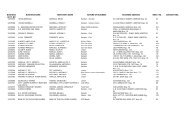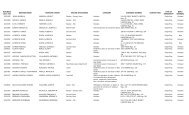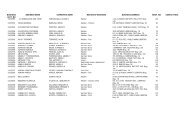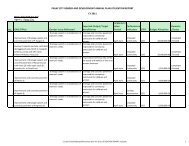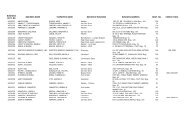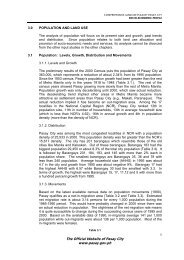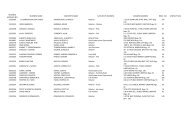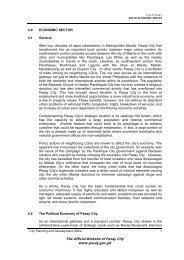Human and Social Devt.5.pdf - Pasay City Government
Human and Social Devt.5.pdf - Pasay City Government
Human and Social Devt.5.pdf - Pasay City Government
- No tags were found...
You also want an ePaper? Increase the reach of your titles
YUMPU automatically turns print PDFs into web optimized ePapers that Google loves.
<strong>City</strong> of <strong>Pasay</strong>SOCIO-ECONOMIC PROFILE5.0 HUMAN AND SOCIAL DEVELOPMENTThis sector covers the following sectors, namely: health, nutrition <strong>and</strong> sanitation,education, culture <strong>and</strong> sports, housing <strong>and</strong> resettlement, public safety <strong>and</strong>protective services, social welfare <strong>and</strong> development. This sector along with theeconomy <strong>and</strong> the physical characteristics of the l<strong>and</strong> constitute the triad thatdetermines l<strong>and</strong>. Its features characteristics that will help formulate theframework by which l<strong>and</strong> use will respond to the human-related needs catering tothe city’s residents.5.1 Health, Nutrition <strong>and</strong> Sanitation5.1.1 HealthBased on the 1996-2000 data of the city health office (Table 5.1), <strong>Pasay</strong> <strong>City</strong> hasgenerally better <strong>and</strong> more stable health indicators than the nation suggesting afairly healthy population. Its crude birth rate of about 23 per 1,000 population islower than the nation’s 26.2 average. Crude date of 4.6 per 1,000 is lower thanthe nation’s 5.8. Its maternal mortality rate of 0.2 is far lower than the country’s0.9. Only in infant mortality is the city a little worse off with its 17.4 per 1,000 livebirths higher than nation’s 17 per 1000 live births.The leading cause of diseases in the city in the last five years was dermatologicfollowed by EENT <strong>and</strong> nutritional deficiency (Table 5.2). In the diseases that canbe compared with the national, the city has a higher incidence of pulmonarytuberculosis but lower incidence of gastro-intestinal diseases. It suggestsproblems of pollution in the city.The leading cause of death in the city in the last five years was diseases of theheart (Table 5.3). This was the same as the nation but <strong>Pasay</strong> has a lowermorbidity rate. However, its number 2, 3 <strong>and</strong> 5 death causes, vascular diseases,pneumonia <strong>and</strong> accidents have higher morbidity rates than the country. Its cancerrate was also higher together with hypertension diseases <strong>and</strong> septicemia. Onother causes, it has lower rates than the nation. This suggests a city beset withmortality problems common to the country.In terms of health facilities, <strong>Pasay</strong> <strong>City</strong> has ample number of tertiary public <strong>and</strong>private hospitals. The biggest of which is San Juan de Dios with a 230-bedcapacity <strong>and</strong> Manila Sanitarium (Table 5.4). Among the government it is theVillamor Air Base Hospital with 150 bed capacity. Initial estimate of the total bedcapacity of the city reveals a total of 647 beds which translates to 1 bed per 648population which is a lot better than the st<strong>and</strong>ard of 1:2,000 bed to populationratio. It is also better than the national ratio of 1 bed for every 873 population.This means <strong>Pasay</strong> <strong>City</strong> has more than adequate hospital facilities to service itsown population <strong>and</strong> nearby towns <strong>and</strong> cities.<strong>Pasay</strong> <strong>City</strong> has two district health offices with about 5 to 6 health units under it.District 1 is a little bigger than District 2 in population <strong>and</strong> all of them are belowthe st<strong>and</strong>ard of 1:50000 health unit to population ratio (Table 5.5) except for SanPablo health unit. This means adequacy in facilities although San Isidro,Ventanilla <strong>and</strong> Malibay may reach critical levels above the st<strong>and</strong>ard in the near<strong>City</strong> Planning <strong>and</strong> Development Office 1The Official Website of <strong>Pasay</strong> <strong>City</strong>www.pasay.gov.ph
<strong>City</strong> of <strong>Pasay</strong>SOCIO-ECONOMIC PROFILEfuture. The city would need about 1 to 4 health units in the next ten years tomeet the st<strong>and</strong>ard.In terms of health personnel, the city is a lot better than the country or NCR interms of number of physicians <strong>and</strong> dentists, (Table 5.6). In nurses it is betterthan NCR but worse off compared to the Philippines in general. In midwives it isbetter than NCR but worse off compared to the country. On sanitary inspectorsthe city’s ratio is more than the st<strong>and</strong>ard of 1:20,000, which means it doesn’t haveenough inspectors to check the sanitary condition of residences <strong>and</strong>establishments. The city also lacks pharmacists <strong>and</strong> nutritionists.Table 5.1Health Indicators, 1996-2000 (per 1,000 population)Indicators 1996 1997 1998 1999 2000 Average PhilsCrude Birth Rate (live births) 23.6 22.5 20.1 21 23 22.0 26.2Crude Death Rate 4.6 4.7 4.4 4.5 5 4.6 5.8Infant Mortality Rate (live births) 17.1 18.6 18.3 18.1 15 17.4 17.0Maternal Mortality Rate (live births) 0.2 0.2 0.24 0.2 0.3 0.2 0.9Note: Philippine figures for CBR <strong>and</strong> CDR is year 2001, for IMR <strong>and</strong> MMR is year 1997Source: <strong>City</strong> Health Office <strong>and</strong> Department of HealthTable 5.2Leading Causes Of Morbidity, 5-Year Average, 1996-2000Diseases Number Rate/ 10,0001. Dermatologic 5,388 138.52. EENT 3,399 87.43. Nutritional Deficiency 3,362 86.44. Respiratory 2,867 73.75. Gastro- intestinal 2,648 68.16. Genito- urinary 2,357 60.67. Muscoloskeletal 1,222 31.48. Pulmonary Tuberculosis 1,087 27.99. Other Acute Viral Illness 396 10.210. Other Infectious Diseases 307 7.9Source: <strong>City</strong> Health Office <strong>and</strong> Department of HealthTable 5.3Leading Causes Of Mortality, 5 Year Average, 1996-2000Diseases Number Rate/ 10,0001. Diseases of Heart 272 6.92. Vascular Diseases 236 6.13. Pnuemonia 230 5.94. Cancer 152 3.95. Accidents 133 3.46. TB all Forms 105 2.77. Hypertension Diseases 102 2.68. Septicemia 49 1.39. Unknown/ undetermined 42 110. Diabetes 25 0.711. Bronchial asthma 25 0.7Source: <strong>City</strong> Health Office <strong>and</strong> Department of Health<strong>City</strong> Planning <strong>and</strong> Development Office 2The Official Website of <strong>Pasay</strong> <strong>City</strong>www.pasay.gov.ph
<strong>City</strong> of <strong>Pasay</strong>SOCIO-ECONOMIC PROFILETable 5.4Hospitals, 2000Name of Hospital Location ABC Classification CategoryPRIVATESan Juan de Dios Educational Foundation, Inc. 2772 Roxas Blvd. 230 General TertiaryManila Sanitarium <strong>and</strong> Hospital 1975 Donada St. 150 General TertiaryMiraculous Medal Hospital NA 42 NA NA<strong>Pasay</strong> Doctors Polyclinic Protacio St. NA NA NABalbido’s Clinical Laboratory NA NA NA<strong>Pasay</strong> Paranaque Chest Clinic NA NA NA NAGOVERNMENT<strong>Pasay</strong> <strong>City</strong> General Hospital P. Burgos St. 100 Charted <strong>City</strong> SecondaryDona Marta Lying-in Clinic 37 Don Carlos Revilla 25 NA NAAir Force General Hospital Villamor Air Base 150 NA NATotal 647Source: <strong>City</strong> Health Office <strong>and</strong> Department of HealthTable 5.5Health Centers, 2000Health CenterBarangayEstimated PopulationServedDISTRICT HEALTH OFFICE ICuyegkeng Bgy 1 to 18 & 20 27,544Leveriza Bgy. 19;21 to 40 29,219San Isidro Bgy. 41 to 67 46,388Main Bgy. 68 to 92 31,366Ventanilla Bgy. 93 to 119 ; 121 to 126 44,386M. dela Cruz Bgy. 12;127 to 143 31,647TOTAL 210,550DISTRICT HEALTH OFFICE IIDona Marta Bgy. 145;151 to 187&190 36,565Malibay Bgy.144;158 to 177 44,557San Pablo Bgy.178 to 177 78,078Kalayaan Bgy.201 17,133MIA Bgy.191 to 200 32,466TOTAL 208,799Source: <strong>City</strong> Health Office <strong>and</strong> Department of HealthTable 5.6<strong>City</strong> Health Office Workforce, 2000TypeRatio to Population Ratio to Population Ratio to PopulationNumberin <strong>Pasay</strong> in Philippinesin NCRPhysicians 24 17,473 27,707 20,533Dentist 17 24,668 52,218 30,576Nurses 23 18,233 17,465 19,474Midwives 57 7,357 5,389 13,210Nutritionist 3 139,783Med-tech 8 52,419Sanitary Inspectors 10 41,935Lab. Aides 10 41,935Pharmacist 1 419,349Utility 16 26,209Drivers 5 83,870Source: <strong>City</strong> Health Office <strong>and</strong> Department of Health <strong>and</strong> from Computations by Consultants<strong>City</strong> Planning <strong>and</strong> Development Office 3The Official Website of <strong>Pasay</strong> <strong>City</strong>www.pasay.gov.ph
<strong>City</strong> of <strong>Pasay</strong>SOCIO-ECONOMIC PROFILE5.1.2 NutritionBased on the nutritional status of children from 1996-2000 in the city, it appearedthat the city has less incidence of malnourishment compared tp the country ingeneral (Table 5.7). The latter has 9.2% prevalence rate compared to the city’srate of less than 2% in the said period. This shows a generally healthypopulation of schoolchildren <strong>and</strong> infants.Table 5.7Nutritional Status of Children, 1996-2000YearPrevalence Rate of Severely <strong>and</strong> ModeratelyUnderweight Children1996 1.1%1997 0.9%1998 0.8%1999 0.7%2000 0.6%Source: <strong>City</strong> Health Office <strong>and</strong> Department of Health5.1.3 SanitationTotal garbage generated per the latest data (circa 1998) revealed that the cityproduced a total of 1,600 cubic meters daily while the amount collected is about1,280 m³ daily. Collection is about 2 trips a day. Thus, there is a shortfall incurrent garbage collection by about 320 cubic meters.5.2 Education, Culture <strong>and</strong> SportsThere are 19 public elementary schools (ES) in the city (Table 5.8). They aredivided into 4 districts, the biggest of which is the South district with about 44% ofthe total enrollment for the year 2000-2001. The biggest elementary school interms of enrollment is the Villamor Air Base ES with about 6,600 students,followed by the Kalayaan ES, both of which are in the South District. In terms ofadequacy of teachers only Maricaban ES <strong>and</strong> Kalayaan ES exhibits criticalshortage since their ratios are way above the st<strong>and</strong>ard of 1:40. Overall, the city’sdivision of city school office projects a total of 107 teachers needed in both public<strong>and</strong> private ES. On number of classrooms, per the report of the said office, thereis no need for additional classrooms since current ratio is way below the st<strong>and</strong>ardrequirements. On the other h<strong>and</strong>, there are about 17 private schools in <strong>Pasay</strong><strong>City</strong> offering elementary education (Table 5.9). The largest of these privateelementary schools is St. Mary’s Academy with 34% of the total private ESenrolment.There are about 4 public secondary schools <strong>and</strong> 1 annex (Table 5.10) in the citywith about 16,600 enrolments. The biggest of which is the <strong>Pasay</strong> <strong>City</strong> South inVillamor Air Base. There are 15 schools offering private secondary education(Table 5.11). The largest of them is Jose Abad Santos HS with 21% of theenrolment followed by St. Mary’s, Sta. Clara <strong>and</strong> Southeastern College. So farbased on the report of the division of city schools, there are about 49 teachersneeded for high school, both in the public <strong>and</strong> private schools. There are noshortages in classrooms as they remain better than the accepted st<strong>and</strong>ard ratioof 1:40.<strong>City</strong> Planning <strong>and</strong> Development Office 4The Official Website of <strong>Pasay</strong> <strong>City</strong>www.pasay.gov.ph
<strong>City</strong> of <strong>Pasay</strong>SOCIO-ECONOMIC PROFILEIn terms of performance, <strong>Pasay</strong> <strong>City</strong>’s elementary schools fared better than therest of the country in terms of less drop-outs (Table 5.12), more survivors, bettertransition rate, more teachers, <strong>and</strong> better results in NEAT. However, it is worseoff in terms of participation rate <strong>and</strong> achievement rate.As far as the high school’s performance is concerned, the city had betterparticipation rate, drop out rates, survival rate; teacher-student ratio, literacy rate<strong>and</strong> NSAT. It is worse off in transition rate, completion rate, <strong>and</strong> achievementrate.Overall the performance indicators in both elementary <strong>and</strong> secondary schools aregood with only the participation rate in elementary meriting a critical look since itmeans less school-age population of the city are enrolling in the city’s elementaryschools. Another problem is the lack of desks <strong>and</strong> armchairs especially in thepublic schools. One very interesting proposal was to create a science highschool. <strong>Pasay</strong> <strong>City</strong> remains one of the few cities in Metro Manila with no suchschool. Such school would create the right environment for the city’s giftedstudents.In tertiary education, there is Lacson College <strong>and</strong> Southeastern College. The cityhas a public university, Pamantasan ng <strong>Pasay</strong> located at the back of <strong>City</strong> Hall.Table 5.8Public Elementary Schools, 2000Districts /Name of SchoolLocationNumber of EnrollmentTeachers 2000-2001RatioNorth District 163 4,791 291 Bernabe ES Bernabe St. 18 355 202 Epifanio Delos Santos ES Tramo St. 41 1,211 303 P. Burgos ES P. Burgos St. 64 2,236 354 Rafael Palma ES Dominga St. 40 989 25East District 326 9,458 291 Juan Sumulong ES M. dela Cruz St. 75 2,026 272 Marcela Marcelo ES Ascaño St., Malibay 71 1,800 253 P. Zamora ES P. Zamora St. 77 2,236 294 Timoteo Paez ES Apelo Cruz. St., Malibay 103 3,396 33West District 193 5,036 261 A. Bonifacio ES Leveriza St., corner Buendia Avenue 49 1,275 262 Gotamco ES Sinciego St. 42 1,214 293 Jose Rizal ES Galvez St., corner Park Avenue 84 2,098 254 P. Villanueva ES P. Villanueva St. 18 449 25South District 392 15,085 381 Apelo Cruz ES E. Rodriguez St., Malibay 42 1,376 332 Cuneta ES 22 753 34<strong>City</strong> Planning <strong>and</strong> Development Office 5The Official Website of <strong>Pasay</strong> <strong>City</strong>www.pasay.gov.ph
<strong>City</strong> of <strong>Pasay</strong>SOCIO-ECONOMIC PROFILETable 5.8Public Elementary Schools, 2000 (Continuation)Districts /Name of SchoolLocationNumber of EnrollmentTeachers 2000-2001Ratio1. Don Carlos ES - 24 759 322. Maricaban ES St. Francis St., Maricaban 15 1,010 673. Kalayaan ES Teachers Bliss Compound, Kalayaan63 3,580 57Village4. Rivera Village ES Marigold St., Rivera Village 31 987 32RVES - Nayon ng NAIA RoadKabataan Annex5. Villamor Air Base ES Villamor Air Base 195 6,620 34Total 1,074 34,370 32Source: DECS website <strong>and</strong> Division of <strong>City</strong> Schools, <strong>Pasay</strong> <strong>City</strong>Table 5.9Private Elementary Schools, 2000Name of School Level Address Enrolment1 Betty's Vermillon Academy PES 2447 Aurora St., <strong>Pasay</strong> <strong>City</strong> 3072 Blessed Elena Academy PES 146 Villaruel St., <strong>Pasay</strong> <strong>City</strong> 5103Christ The King Aca. (formerlyChristian Life Aca.)PES 2562 Zamora St., <strong>Pasay</strong> <strong>City</strong>724 Gideon Academy PES 2683 F.B. Harrison St., <strong>Pasay</strong> <strong>City</strong> 1985Golden Treasure Baptist Academy PE 2909 E. Rodriguez St., Malibay, <strong>Pasay</strong><strong>City</strong> 746Integrated Montessori PE E-B Jusmag Southside, Ft. Bonifacio,<strong>Pasay</strong> <strong>City</strong>7Ma.Montessori Children's SchoolFound., Inc.PE 50 William St. cor. F.B. Harrison, <strong>Pasay</strong><strong>City</strong> 1778 <strong>Pasay</strong> <strong>City</strong> Academy ES 2059 Donada St., <strong>Pasay</strong> <strong>City</strong> 3199<strong>Pasay</strong> Alliance Christian School PES 533 Cementina St., Libertad Ext., <strong>Pasay</strong><strong>City</strong> 7410Philippine <strong>Pasay</strong> Chung HuaAcademyPES 2269 Luna St., <strong>Pasay</strong> <strong>City</strong>79211 Rizal <strong>City</strong> School PES M. dela Cruz St., <strong>Pasay</strong> <strong>City</strong> 10012 St. Mary's Academy PES P. Burgos St., <strong>Pasay</strong> <strong>City</strong> 2,486St. Therese Parochial School PE Manlunas St., Villamor Air-Base, <strong>Pasay</strong>13<strong>City</strong> 34714 San Isidro Catholic School PES 1830 Taft Avenue, <strong>Pasay</strong> <strong>City</strong> 56015 San Juan Nepomuceno School PE 826 Apelo Cruz Ext.,Malibay,<strong>Pasay</strong> <strong>City</strong> 342St. Mary of the Steps School (Scuola PE S 92 C. Jose Malibay St., <strong>Pasay</strong> <strong>City</strong>16 Madonna)21917 Southeastern College PESCV College Road, Taft Avenue, <strong>Pasay</strong> <strong>City</strong> 830TOTAL 7,407Source: DECS websiteTable 5.10Public High Schools, 2000Name of School Location Enrollment1 <strong>Pasay</strong> <strong>City</strong> North HS Tramo St., <strong>Pasay</strong> <strong>City</strong> 2,182PCNHS Cuneta AnnexPark Avenue, <strong>Pasay</strong> <strong>City</strong>2 <strong>Pasay</strong> <strong>City</strong> East HS Malibay, <strong>Pasay</strong> <strong>City</strong> 3,9653 <strong>Pasay</strong> <strong>City</strong> West HS F.B. Harrision, <strong>Pasay</strong> <strong>City</strong> 5,2044 <strong>Pasay</strong> <strong>City</strong> South HS Villamor Air Base, <strong>Pasay</strong> <strong>City</strong> 5,304TOTAL 16,655Source: DECS website<strong>City</strong> Planning <strong>and</strong> Development Office 6The Official Website of <strong>Pasay</strong> <strong>City</strong>www.pasay.gov.ph
<strong>City</strong> of <strong>Pasay</strong>SOCIO-ECONOMIC PROFILETable 5.11Private Secondary Schools, 2000Name of School Level Address Enrollment1 Jose Abad Santos High School S 3058 Taft Avenue, <strong>Pasay</strong> <strong>City</strong> 1,719(Arellano Univ.)2 A. Mabini High School (Arellano Univ.) S Taft Avenue, <strong>Pasay</strong> <strong>City</strong> 5483 Betty's Vermillon Academy PES 2447 Aurora St., <strong>Pasay</strong> <strong>City</strong> 514 Blessed Elena Academy PES 146 Villaruel St., <strong>Pasay</strong> <strong>City</strong> 4215 Christ The King Aca. (formerly PES 2562 Zamora St., <strong>Pasay</strong> <strong>City</strong> 55Christian Life Aca.)6 Gideon Academy PES 2683 F.B. Harrison St., <strong>Pasay</strong>96<strong>City</strong>7 Lacson College SC 2188 F.B. Harrison St., <strong>Pasay</strong>146<strong>City</strong>8 <strong>Pasay</strong> Alliance Christian School PES 533 Cementina St., Libertad37Ext., <strong>Pasay</strong> <strong>City</strong>9 Philippine <strong>Pasay</strong> Chung Hua Academy PES 2269 Luna St., <strong>Pasay</strong> <strong>City</strong> 41110 <strong>Pasay</strong> <strong>City</strong> Academy ES 2059 Donada St., <strong>Pasay</strong> <strong>City</strong> 26711 Rizal <strong>City</strong> School PES M. dela Cruz St., <strong>Pasay</strong> <strong>City</strong> 22212 St. Mary's Academy PES P. Burgos St., <strong>Pasay</strong> <strong>City</strong> 1,30213 San Isidro Catholic School PES 1830 Taft Avenue, <strong>Pasay</strong> <strong>City</strong> 25914 Sta. Clara Parish School S 2360 P. Burgos St., <strong>Pasay</strong> <strong>City</strong> 1,30015 St. Mary of the Steps School (Scuola PE S 92 C. Jose Malibay St., <strong>Pasay</strong>64Madonna)<strong>City</strong>16 Southeastern College PESCV College Road, Taft Avenue,1,294<strong>Pasay</strong> <strong>City</strong>TOTAL 8,192Source: DECS websiteTable 5.12Performance Indicators of Public Schools, 1997-2000Elementary CY- 97 CY- 98 CY- 99 CY- 2000 AVE PHILEnrolment 33,699 34,092 33,993 34,310 34,3101. Participation Rate 78.06 79 94.57 93.32 86 96.34%2. Retention Rate 94.46 93.02 94.57 84.38 94 NA3. Drop- out Rate 1.48 1:11 1.5 1.30 1 7.98%4. Survival Rate 70.75 71.54 90.50 91.00 91 68.56%5. Transition Rate 92.85 96.64 96.19 96.48 96 95.25%6. Completion Rate 92.45 92.16 97.18 93 95 68.06%7. Graduation Rate 94.13 96.31 95.84 97.43 97 NA8. Teacher- Student Ratio 32 32 32 32 32 34.389. Literacy Rate 92.20 96.99 96.64 97 97 NA10. Achievement Rate 69.75 76.96 55.78 68.50 70 73.2%11. Student- Textbook Ratio 1 1 1 1 1 NA12. NEAT 58.44 61.3 53.97 N/A 58 46.86SecondaryEnrolment 16,251 16,850 15,923 16,458 15,9231. Participation Rate 56.02 57.70 84.49 86.28 84 64.68%2. Retention Rate 92.62 86.26 98.99 94 93 NA3. Drop- out Rate 8.94 7.78 7.05 6.56 7 10.59%4. Survival Rate 83.06 74.1 89.67 91% 74 71.78%5. Transition Rate 97.71 98.78 100% 100% 98 100.19%6. Completion Rate 94.47 92.10 95.5 93 94 69.62%7. Graduation Rate 80.37 93.04 95.87 95.25 80 NA8. Teacher- Student Ratio 32 32 31 31 32 34.875<strong>City</strong> Planning <strong>and</strong> Development Office 7The Official Website of <strong>Pasay</strong> <strong>City</strong>www.pasay.gov.ph
<strong>City</strong> of <strong>Pasay</strong>SOCIO-ECONOMIC PROFILETable 5.12Performance Indicators Public Schools, 1997-2000 (Continuation)Elementary CY- 97 CY- 98 CY- 99 CY- 2000 AVE PHIL9. Literacy Rate 100% 100% 100% 100% 100% 95.3810. Achievement Rate 42.06 62.48 58.55 57.24 42 94.76%11. Student- Textbook Ratio 1 1 1 1 1 NA12. NSAT 58.16 53.52 58.69 - 58 46.44Source: DECS website <strong>and</strong> Division of <strong>City</strong> Schools, <strong>Pasay</strong> <strong>City</strong>5.3 Housing <strong>and</strong> Resettlement5.3.1. HousingThe latest Census of Housing was vintage 1990. This report relies heavily on thisdata despite its being dated since important patterns <strong>and</strong> characteristics are stillapparent that will illuminate the housing situation in <strong>Pasay</strong>.<strong>Pasay</strong> as of 1990 had 61,539 houses exhibiting an annual growth of 1.3% from1980, which is twice as low as NCR (Table 5.13). Highest growth was registeredduring the 1970-1980 period. In the 1980-1990 period, vacant houses grew thehighest but <strong>Pasay</strong>’s rate was lower than NCR. This suggest that <strong>Pasay</strong> isutilizing more its existing houses <strong>and</strong> have less problems associated with vacanthouses.Out of the occupied housing units of 60,087, 62% are single houses (Table 5.14)in <strong>Pasay</strong>. Multi-unit residential with 9% follows this. In terms of household tooccupied housing units, <strong>Pasay</strong> had 1.229 which is significantly higher than NCR’s1.094. This suggests that <strong>Pasay</strong>’s has lot of households crammed in singlehouses especially in crowded residential areas. In terms of household populationto occupied housing unit, <strong>Pasay</strong> again has higher ratio relative to NCR. Thisreinforces the findings that <strong>Pasay</strong>’s housing was relatively congested.The construction materials of <strong>Pasay</strong>’s houses are relatively light (Table 5.16)when compared with NCR which is the proxy for the regional average. It hashigher percentage of house with wood as the construction materials. Thissuggests that <strong>Pasay</strong> has opportunities for non-light construction materials. At thesame time it also reflects the lower st<strong>and</strong>ards of production of many houses in thecity.Houses in <strong>Pasay</strong> was relatively new since 21% of its houses were built in the last15 years (Table 5.17) compared to the NCR’s 19%. There was a surge ofconstruction during the 1986-1990 period in the city. It has lower percentage ofhouses that needs no repair but conversely it has higher percentage of housesthat needs major repair. This suggests that <strong>Pasay</strong> would have houses needingreplacement maybe with more permanent structures. This reinforces thepreceding finding.Less than 50% of <strong>Pasay</strong> residents owned their houses while a significant sharerent their houses (Table 5.18). Many of them were in single <strong>and</strong> multi-unitresidential houses. This suggests that <strong>Pasay</strong> is quite vulnerable to the mobility ofits renting residents. This could be a reason for the decline of population of<strong>City</strong> Planning <strong>and</strong> Development Office 8The Official Website of <strong>Pasay</strong> <strong>City</strong>www.pasay.gov.ph
<strong>City</strong> of <strong>Pasay</strong>SOCIO-ECONOMIC PROFILE<strong>Pasay</strong>. However, there is the big opportunity for offering housing schemes thatwill lead to ownership.5.3.2 ResettlementBased on the LGU’s April 2000 report <strong>Pasay</strong> has about 33,433 settler familiesthat can be considered as informal settlers whom we usually associate the termurban poor. <strong>Pasay</strong>’s informal settlers partakes 23% of the south sectors totalnumber of informal squatters (Table 5.18). This is quite significant. This suggesta holistic approach is needed. More than half are in APD while a largepercentage is squatting on private l<strong>and</strong>s <strong>and</strong> tourism areas.Table 5.13Housing Units <strong>and</strong> Occupancy Status, 1960-1990Year Occupancy Status <strong>Pasay</strong> <strong>City</strong> % ShareNCR % Annual NCR AnnualShare Growth Growth1960 Total Housing Units 21,490 100.0% 100.0%Occupied 21,151 98.4% 99.1%Vacant 339 1.6% 0.9%1970 Total Housing Units 33,302 100.0% 100.0% 4.5% 4.9%Occupied 32,587 97.9% 97.3% 4.4% 4.7%Vacant 715 2.1% 2.7% 7.7% 17.0%1980 Total Housing Units 53,948 100.0% 100.0% 4.9% 5.8%Occupied 53,191 98.6% 98.1% 5.0% 5.8%Vacant 757 1.4% 1.9% 0.6% 1.9%1990 Total Housing Units 61,539 100.0% 100.0% 1.3% 3.2%Occupied 60,087 97.6% 96.8% 1.2% 3.1%Vacant 1,452 2.4% 3.2% 6.7% 9.0%Source: NSO, 1990Table 5.14Occupied Housing Units, Households, Household Population by Type of Building, 1990Type of Bldg, Area of ClassificationOccupied HousingUnitsHouseholds toOccupied HousingUnitsHouseholdsPopulation toOccupied HousingUnitsNCR 1,435,365 1.094 5.509Single House 878,416 1.084 5.607Duplex 127,042 1.093 5.369Multi-Unit Residential 411,531 1.114 5.363Commercial/Industrial/Agricultural 10,382 1.102 5.187Institutional Living Quarters 452 1.104 4.527Other Housing Units 5,326 1.094 5.002Not Reported 2,216 1.000 4.708<strong>Pasay</strong> <strong>City</strong> 60,087 1.229 6.103Single House 37,015 1.234 6.266Duplex 5,265 1.242 6.020Multi-Unit Residential 16,924 1.222 5.831Commercial/Industrial/Agricultural 481 1.094 5.106Institutional Living Quarters 11 1.636 6.091Other Housing Units 276 1.072 4.826Not Reported 115 1.000 4.617Source: NSO, 1990Table 5.15<strong>City</strong> Planning <strong>and</strong> Development Office 9The Official Website of <strong>Pasay</strong> <strong>City</strong>www.pasay.gov.ph
<strong>City</strong> of <strong>Pasay</strong>SOCIO-ECONOMIC PROFILEConstruction Materialsof the Outer WallsPercentage of Occupied Housing Units by Construction Materialsof the Outer Walls <strong>and</strong> Roof in <strong>Pasay</strong> <strong>City</strong> <strong>and</strong> NCR: 1990TotalOccupiedHousingUnitsGalvanizedIron/AluminumTile/Concrete/Clay TileConstruction Materials of the RoofHalfGalvanizedIron<strong>and</strong> HalfConcreteWoodCogon/Nipa/AnahawMakeshift/Salvaged/ImprovisedAsbestos/OthersNotReportedNATIONAL CAPITALREGION 100% 80% 3% 9% 5% 1% 3% 0% 0%Concrete/Brick/Stone 33% 30% 2% 1% 0% 0% 0% 0% 0%wood 27% 22% 0% 1% 4% 0% 0% 0% 0%Half Concrete/Brick/Stone<strong>and</strong> Half Wood 34% 25% 1% 7% 0% 0% 0% 0% 0%Galvanized Iron/Aluminum 1% 0% 0% 0% 0% 0% 0% 0%Bamboo/Sawali/Cogon/Nipa 1% 0% 0% 0% 0% 0% 0% 0%Makeshift/Salvaged/Improvised 4% 1% 0% 0% 0% 2% 0% 0%Asbestos/Glass/Others 0% 0% 0% 0% 0% 0% 0% 0% 0%No Walls/Not Reported 0% 0% 0% 0% 0% 0% 0% 0% 0%PASAY 100% 76% 3% 9% 7% 1% 3% 1% 0%Concrete/Brick/Stone 20% 17% 2% 0% 0% 0% 0% 1% 0%wood 36% 28% 1% 1% 6% 0% 0% 0% 0%Half Concrete/Brick/Stone<strong>and</strong> Half Wood 38% 29% 1% 8% 0% 0% 0% 0%Galvanized Iron/Aluminum 1% 0% 0% 0% 0% 0% 0%Bamboo/Sawali/Cogon/Nipa 1% 0% 0% 0% 0% 0% 0% 0%Makeshift/Salvaged/Improvised 4% 1% 0% 0% 0% 3% 0% 0%Asbestos/Glass/Others 0% 0% 0% 0% 0% 0% 0%No Walls/Not Reported 0% 0% 0% 0% 0% 0% 0%Source: Derived from NSO, 1990Year Built<strong>and</strong> <strong>City</strong>/MunicipalityTable 5.16Occupied Housing Units by Condition (State of Repair) of the Building,Year Built in <strong>Pasay</strong> <strong>City</strong> <strong>and</strong> NCR: 1990CONDITION (STATE OF REPAIR) OF THE BUILDINGTotalOccupiedHousingUnitsNeed NoRepair/NeedsMinorRepairNeedsMajorRepairDilapidated/CondemnedUnderRenovation/BeingRepairedUnderConst’nUnfinishedConst’nNotReportedNATIONAL CAPITALREGION 100% 75% 20% 2% 1% 1% 2% 0%1986-1990 19% 13% 4% 0% 0% 1% 1% 0%1981-1985 19% 14% 4% 0% 0% 0% 0% 0%1971-1980 24% 19% 4% 0% 0% 0% 0% 0%1961-1970 14% 11% 3% 0% 0% 0% 0% 0%1951-1960 8% 6% 2% 0% 0% 0% 0% 0%1950 or earlier 7% 5% 2% 0% 0% 0% 0% 0%Not applicable 0% 0% 0% 0% 0% 0% 0% 0%Don’t know/ Not reported 9% 7% 2% 0% 0% 0% 0% 0%PASAY CITY 100% 73% 21% 2% 1% 1% 2% 0%1986-1990 21% 14% 5% 0% 0% 1% 1% 0%1981-1985 15% 11% 3% 0% 0% 0% 0% 0%<strong>City</strong> Planning <strong>and</strong> Development Office 10The Official Website of <strong>Pasay</strong> <strong>City</strong>www.pasay.gov.ph
<strong>City</strong> of <strong>Pasay</strong>SOCIO-ECONOMIC PROFILEYear Built<strong>and</strong> <strong>City</strong>/MunicipalityTable 5.15Occupied Housing Units by Condition (State of Repair) of the Building,Year Built in <strong>Pasay</strong> <strong>City</strong> <strong>and</strong> NCR: 1990 (Continuation)CONDITION (STATE OF REPAIR) OF THE BUILDINGTotalOccupiedHousingUnitsNeed NoRepair/NeedsMinorRepairNeedsMajorRepairDilapidated/CondemnedUnderRenovation/BeingRepairedUnderConst’nUnfinishedConst’nNotReported1971-1980 20% 15% 4% 0% 0% 0% 0% 0%1961-1970 15% 12% 3% 0% 0% 0% 0% 0%1951-1960 7% 6% 2% 0% 0% 0% 0% 0%1950 or earlier 8% 5% 2% 0% 0% 0% 0% 0%Not applicable 0% 0% 0% 0% 0% 0% 0% 0%Don’t know/ Not reported 14% 10% 3% 0% 0% 0% 0% 0%Source: Derived from NSO, 1990Table 5.16Households by Type of Building, Tenure Status of the Housing Unitin <strong>Pasay</strong> <strong>City</strong> <strong>and</strong> NCR: 1990Housing Unit <strong>and</strong> Area ClassificationTotalHouseholdsSingleHouseDuplexMulti-unitResidential(3 units or more)NATIONAL CAPITAL REGION 100% 61% 9% 29%Owned/Being Amortized 61% 44% 5% 12%Rented 30% 12% 3% 15%Being Occupied for Free With Consent of Owner 8% 5% 1% 2%Being Occupied for Free W/out Consent of Owner 1% 1% 0% 0%PASAY 100% 62% 9% 28%Owned/Being Amortized 49% 35% 4% 9%Rented 43% 21% 4% 17%Being Occupied for Free With Consent of Owner 7% 5% 1% 2%Being Occupied for Free W/out Consent of Owner 1% 1% 0% 0%Table 5.17Magnitude of Informal Settlers in <strong>Pasay</strong> <strong>and</strong> South Sector, as of April 11, 2000LocationSouth% Share To% Share To<strong>Pasay</strong> <strong>City</strong>TotalSouth TotalDANGER AREAWaterways 16,527 11% 3,804 3%Railroad Tracks 4,854 3% -Pasig River 2,285 2% -Sub-total 23,666 16% 3,804 3%GOVERNMENT INFRASTRUTUREROW 975 1% 120 0%Public Utilities 1,412 1% -Sub-total 2,387 2% 120 0%GOV'T. OWNED LANDS 34,670 24% -PRIVATELANDS 60,804 42% 8,683 6%TOURISM AREAS 5,650 4% 5,650 4%DESIGNATED HOUSING SITES 142 0% -APDs 17,480 12% 15,176 10%144,799 100% 33,433 23%Note: South includes Paranaque, Muntinlupa, Las Pinas, Makati, Tagig, PaterosSource: LGU 11 April 2000<strong>City</strong> Planning <strong>and</strong> Development Office 11The Official Website of <strong>Pasay</strong> <strong>City</strong>www.pasay.gov.ph
<strong>City</strong> of <strong>Pasay</strong>SOCIO-ECONOMIC PROFILE5.4 Public Safety <strong>and</strong> Protective ServicesThe city has 24 fire trucks with a total capacity of 27,500 gallons. Using the 2000population of 354,908, this capacity makes for a truck to population ratio of1:14,787. This is within the range of acceptable number of ‘population to a firetruck, which is 10,000 to 50,000 per one truck. Incidents of fire averages 108 peryear, many these fires are of residential houses (Table 5.13). This trend has beendeclining since 1997. The damages, however, have become staggeredaveraging to P 237,914,870. In conclusion, the fire protection sub-sector hasbeen generally well with adequate facilities <strong>and</strong> declining number of fires — whichmeans fire prevention campaign has been successful.The city has a total police force of 387 police personnel. With a projectedpopulation of 444,027 in 2001, the police population ratio is about 1:1,147 whichis quite deficient considering the st<strong>and</strong>ard ratio of 1:500. Performance hasimproved from 1999 to 2000.Table 5.18Number of Fire Incidents (1997-2001)Year Number of Fire Incident Estimated Damage (PhP)1997 157 7,578,3101999 99 179,191,3002000 67 526,975,0002001 36 549,256,500AVERAGE (1997-2000) 108 237,914,870Source: <strong>City</strong> <strong>Government</strong>Table ___ Protective Services PNP:Non-uniform (civilian) 21Non-officers (from PO1-SPO4) 344Officers (from Inspector – Superintendent) 43TOTAL 4081999 2000Crime Index 487 467Non Index 591 390Crime Volume 1078 857Crime Solved 1019 850Crime Solution Efficiency 94.50% 99.80%(volume/solved)Ave. monthly crime rate (AMCR) 22.30 22.28Ave. Monthly Index Crime Rate (AMICR) 12.77 12.26Ave. Monthly Non-Index Crime Rate 15.50 10.24(per 100,000 population)Note: as of As of April 3, 2001<strong>City</strong> Planning <strong>and</strong> Development Office 12The Official Website of <strong>Pasay</strong> <strong>City</strong>www.pasay.gov.ph
<strong>City</strong> of <strong>Pasay</strong>SOCIO-ECONOMIC PROFILE5.5 <strong>Social</strong> Welfare <strong>and</strong> DevelopmentThe city’s <strong>Social</strong> Welfare Department has 13 unit offices of which seven are inDistrict 1 while the rest are in District 2. It has 70 accredited day care centers<strong>and</strong> 11 special service units. The bulk of their services are mostly to distressedfamilies (etc., disasters, typhoons).Analysis of the performance of the past two years (Table 5.14 refers) showed thatthe city reduced its number of family-related clients by 26% <strong>and</strong> increased itsyouth-related services by 10 folds. Children-related services <strong>and</strong>senior/h<strong>and</strong>icap-related-services also increased significantly. Comparing theseresults with the structure of national services, the city’s make up of social welfareclients are far different than the national make up. It has more children- <strong>and</strong>senior-related services while the national has mostly family-related activities.This suggests that the city is proportionally experiencing more children-relatedproblems like street children, homelessness etc. which are usual sights in thecity. This also suggests the aging of the population of the city.Table 5.19<strong>Social</strong> Welfare Clientele, 1999-2000Clientele Category 1999 2000% Change 2000 % RP %99-00 Share ShareFamilies 5,152.00 3,805.00 -26% 22% 72%Children 5,727.00 8,223.00 44% 46% 11%Youth 129.00 1,593.00 1135% 9% 4%Women 1,160.00 1,214.00 5% 7% 11%Persons With Disabilities (PWDs)/Senior 2,428.00 2,854.00 18% 16% 2%Citizens (SCs)/Older PersonsDistressed 11,238.00 11,874.00 6%Total 25,834.00 29,563.00 14% 100% 100%<strong>City</strong> Planning <strong>and</strong> Development Office 13The Official Website of <strong>Pasay</strong> <strong>City</strong>www.pasay.gov.ph



